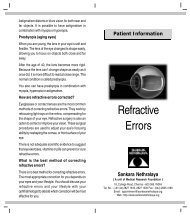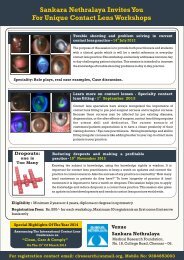Corneal Ulcer - Sankara Nethralaya
Corneal Ulcer - Sankara Nethralaya
Corneal Ulcer - Sankara Nethralaya
You also want an ePaper? Increase the reach of your titles
YUMPU automatically turns print PDFs into web optimized ePapers that Google loves.
Patient Information<br />
<strong>Corneal</strong><br />
<strong>Ulcer</strong><br />
A defect in the surface of the cornea with a creamy<br />
white spot associated with redness. It may be caused<br />
by infection or trauma. The infecting organisms can<br />
be anything; fungus, bacteria or virus.<br />
<strong>Sankara</strong> <strong>Nethralaya</strong><br />
( A unit of Medical Research Foundation )<br />
18, College Road, Chennai - 600 006. INDIA<br />
Tel. No. : (+91 44) 2827 1616, 2827 1035 Fax : (044) 2825 4180<br />
Email : appointment@sankaranethralaya.org<br />
Web : http://www.sankaranethralaya.org
What are the causes of<br />
corneal ulcer?<br />
<strong>Corneal</strong> ulcers are most commonly caused by an<br />
infection with bacteria, viruses, fungi. Other causes are<br />
abrasions or foreign bodies, inadequate eyelid closure,<br />
severe dry eyes, severe allergic eye disease, contact<br />
lens wearers and various other inflammatory disorders.<br />
What happens to the <strong>Ulcer</strong>?<br />
Only a small scar is formed if the ulcer is treated at the<br />
early stage. If treatment is delayed, the ulcer leaves a<br />
dense scar, which leads to poor visual prognosis.<br />
Treatment :<br />
Treatment of corneal ulcers and infections depends<br />
upon the cause, and should be treated as soon as<br />
possible to prevent further injury to the cornea. Broad<br />
antibiotic coverage is started and then more specific<br />
antibiotic, antiviral, or antifungal eye drops are<br />
prescribed (as soon as the type of ulcer has been<br />
identified). The patient should be checked for his blood<br />
glucose level or history of diabetes.Severe ulcers may<br />
need to be treated with corneal transplantation.<br />
<strong>Corneal</strong> Transplant :<br />
If the cornea becomes cloudy, the only way to restore<br />
sight is to replace it with a healthy donor cornea through<br />
eye donation.<strong>Corneal</strong> transplantation (keratoplasty) is<br />
the most successful of all tissue transplants with an<br />
overall success rate greater than 90%.The success rate<br />
mostly depends on the cause of the corneal opacity.<br />
Visual Prognosis<br />
Visual Prognosis depends on the site, size of corneal<br />
ulcer, time of starting treatment and the complications<br />
encountered. All corneal ulcers heal with a scar. If it is in<br />
the center of visual axis, refraction of light is affected. If<br />
the ulcer is small and situated in the periphery of cornea,<br />
it will carry a good prognosis.<br />
Avoid injury to the eyes Wear protective glasses when<br />
working in Quarry, Lathe & welding workshops. Upon<br />
injury, Consult an eye doctor immediately. Never use<br />
home remedies/native medicines in your injured eye.<br />
Never use left over medicines for any eye injury. Never<br />
use steroids for eye injury.
















